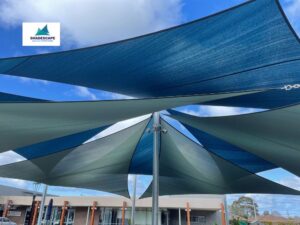Shade sails offer flexible and visually appealing options for an outdoor room designed to be comfortable and stylish. It is one of the most desirable ways to create a resting space outdoors. At Shadescape, we understand that the right shade sail completely changes how your backyard, patio, or even any commercial area looks and feels-an uplifted environment that keeps you sheltered from the sun. We have an extensive range of commercial shade sails for all kinds of application requirements.
However, to really get value from shade sails, it’s important to understand the materials involved in their design. This blog explains a number of materials that go into designing shade sails, properties, and how these properties will influence performance, durability, and aesthetics.
Common Shade Sails Material
-
Polyester Fabric
Polyester is very common for shade sails since it is strong, durable, and relatively cheap. It’s synthetic fabric; therefore, it resists UV rays as well as mould and mildew.
Pros:
- Lightweight, easy to install.
- Available just about everywhere, wide variety of colour options and designs available
- Fade resistant, great outdoor shade fabric
Cons
- Could be less breathable compared to the other fabrics, which results in heat retention at the sail bottom.
- It will ultimately degrade when subjected to significant environmental forces.
-
High-Density Polyethylene (HDPE)
HDPE is one of the most popular shade sail material types as it demonstrates excellent resistance against UV-rays while at the same time breathable. This type of woven material allows air circulation in addition to blocking harmful rays. It qualifiesas an ideal shade sail for hot climatic environments.
Pros:
- Boasts strong UV resistance. This essentially blocks about 95% of detrimental rays.
- Breathable, so air can pass through the material; this really cuts down on heat build-up.
- Available in a number of weaves and colors.
Cons:
- A bit more maintenance-intensive when it comes to cleaning.
- A bit heavier than polyester, so installation might be slightly different
-
Canvas
Traditionally made of either cotton or linen, canvas is a more classic and strengthened material for shade sails. However, the ones for the present days are usually blended synthetic fibres with the natural ones to increase durability and resistance to the weather.
Pros:
- The material will be capable of withstanding wear and tear.
- It provides a more authentic look.
- If the waterproof coating is applied, then the material will prove to be water resistant.
Cons:
- Heavier than other material, which may make installation a bit complicated.
- May give rise to mould and mildew if not properly treated.
-
PVC-Coated Fabric
PVC-coated fabrics are synthetic materials with a coat of polyvinyl chloride. That makes them very strong and resistant to water, hence useful for areas that experience heavy rainfall or moisture.
Pros:
- It offers extraordinary water resistance and is thus suitable for very rainy climates.
- It is also highly durable and resistant to fading and ripping.
- Easy cleaning and maintenance.
Cons:
- Not as breathable compared to other materials thus may trap heat.
- Generally, pricier than other fabric selections.
-
Acrylic Fabric
Acrylic fabrics are available in vibrant colors with high durability UV resistance. The materials can be used in the marine environment and also suitable for outdoor usage since it doesn’t fade or grow mildew.
Pros:
- Excellent UV protection and colour retention.
- Resists mould and mildew
- Double soft and feels luxurious
- It is expensive
- Fades very fast if not well maintained.
-
Mesh Fabrics
They have an extremely interesting open-weave that maximises the air circulation and diffusion of light. They can widely be used in commercial applications such as a parking lot or outdoor dining areas.
Pros:
- It allows great ventilation, thus ensuring that the building does not retain a lot of heat.
- Lightweight and easy to install.
- Often blocks lots of UV rays but will let some light filter in.
Cons:
- It will not block direct sun rays as well as solid fabrics.
- It will not provide adequate cover when it is raining so hard.
Shade Sail Materials – Some Things to Consider
While determining which material best suited to your shade sail, consider the following factors:
- Climate
Let’s consider the knowledge of your local climate. If it allows exposure to more UVs, use HDPE or acrylic. If you are staying in a rainy region, then use PVC-coated fabrics.
- Use
Consider what you will use it for, whether recreation or business. If it’s for recreation, you want materials with breathability as people need comfort. Business or commercial places will require more durable and stronger material.
- Design Preferences
The look of your shade sail is going to impact the aesthetic appeal of your outdoor space overall. Materials vary widely in color, texture, and pattern so you may want to consider which one fits your design concept.
- Maintenance Requirements
Other materials require more work than others. Acrylic and PVC-coated fabrics are pretty easy to clean while on canvas, one needs a bit of elbow grease not to let mould and mildew form.
To Wind It Up!
Shade sails are a wonderful addition to any outdoor space as they not only provide protection but also great aesthetic appeal. The materials used in the construction of shades will determine its performance and durability as well as giving it that appearance. Here at Shadescape Sails and Structures, we have a variety of domestic shades made of high-quality materials, such that you find the perfect solution for your needs.






